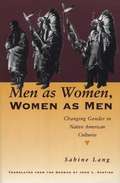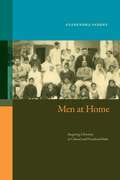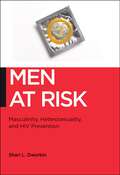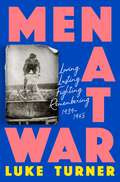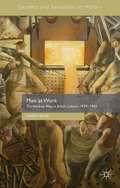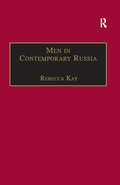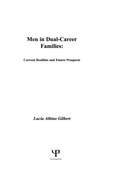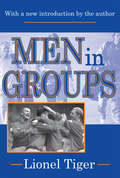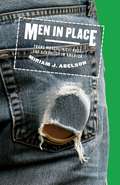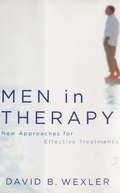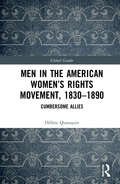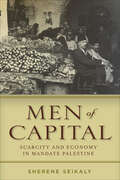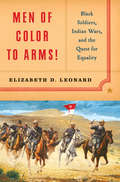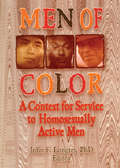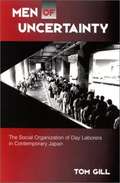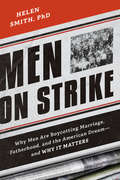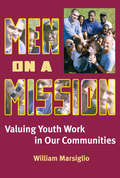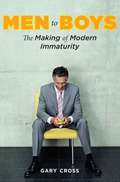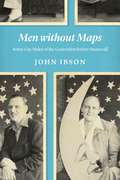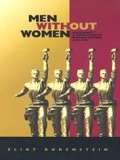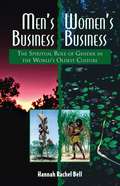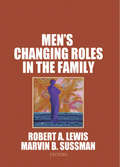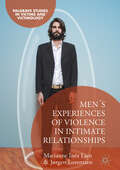- Table View
- List View
Men as Women, Women as Men: Changing Gender in Native American Cultures
by Sabine LangAs contemporary Native and non-Native Americans explore various forms of "gender bending" and gay and lesbian identities, interest has grown in "berdaches," the womanly men and manly women who existed in many Native American tribal cultures. Yet attempts to find current role models in these historical figures sometimes distort and oversimplify the historical realities. This book provides an objective, comprehensive study of Native American women-men and men-women across many tribal cultures and an extended time span. As contemporary Native and non-Native Americans explore various forms of "gender bending" and gay and lesbian identities, interest has grown in "berdaches," the womanly men and manly women who existed in many Native American tribal cultures. Yet attempts to find current role models in these historical figures sometimes distort and oversimplify the historical realities. This book provides an objective, comprehensive study of Native American women-men and men-women across many tribal cultures and an extended time span. Sabine Lang explores such topics as their religious and secular roles; the relation of the roles of women-men and men-women to the roles of women and men in their respective societies; the ways in which gender-role change was carried out, legitimized, and explained in Native American cultures; the widely differing attitudes toward women-men and men-women in tribal cultures; and the role of these figures in Native mythology. Lang's findings challenge the apparent gender equality of the "berdache" institution, as well as the supposed universality of concepts such as homosexuality.
Men at Home: Imagining Liberation in Colonial and Postcolonial India
by Gyanendra PandeyIn Men at Home, Gyanendra Pandey offers a detailed exploration of men’s comportment and conduct in the home and the implications of their ambiguous commitment to this critical part of their lives. The author draws on a wealth of archival materials—autobiographies, memoirs, fiction, and ethnographies—to situate Indian men firmly in the domestic world, underlining their dependence on the family and home. He investigates how men negotiate marriage, intimacy, and conjugality and focuses the effects of the humiliating and constant assertion of gender, caste, and class power in familial interactions. To uncover the nuances of these relationships, Pandey attends to the domestic commitments of upper-, middle-, and lower-class men across religion and caste. He considers issues of honor and shame, rights and responsibilities, citizenship and belonging through this exploration of how men across the subcontinent understand themselves in and beyond their domestic relationships. As much as it is a book about masculinity and conjugality, this is a book about Indian modernity, nationalism, and society as seen from the location of men in the home.
Men at Leisure
by Bruce FredericksonGodly Man series/examines men at leisure from Biblical perspective
Men at Risk: Masculinity, Heterosexuality and HIV Prevention (Biopolitics #17)
by Shari L. DworkinPresents a unique approach to HIV prevention at the intersection of sociological and public health researchAlthough the first AIDS cases were attributed to men having sex with men, over 70% of HIV infections worldwide are now estimated to occur through sex between women and men. In Men at Risk, Shari L. Dworkin argues that the centrality of heterosexual relationship dynamics to the transmission of HIV means that both women and men need to be taken into account in gender-specific HIV/AIDS prevention interventions. She looks at the “costs of masculinity” that shape men’s HIV risks, such as their initiation of sex and their increased status from sex with multiple partners.Engaging with the common paradigm in HIV research that portrays only women—and not heterosexually active men—as being “vulnerable” to HIV, Dworkin examines the gaps in public health knowledge that result in substandard treatment for HIV transmission and infection among heterosexual men both domestically and globally. She examines a vast array of structural factors that shape men’s HIV transmission risks and also focuses on a relatively new category of global health programs with men known as “gender-transformative” that seeks to move men in the direction of gender equality in the name of improved health. Dworkin makes suggestions for the next generation of gender-transformative health interventions by calling for masculinities-based and structurally driven HIV prevention programming. Thoroughly researched and theoretically grounded, Men at Risk presents a unique approach to HIV prevention at the intersection of sociological and public health research.
Men at War: Loving, Lusting, Fighting, Remembering 1939-1945
by Luke TurnerAs a child, Luke Turner was obsessed with the Second World War. He spent hours watching Sunday war films, poring over stories of derring-do and relishing in birthday trips to air museums. Lying in bed beneath Airfix fighter planes suspended from his ceiling, he would think about the men that might sit in their cockpits, and whether he could ever be one of them. Now, as an adult who has come to terms with a masculine identity and sexuality that is often erased from dominant military narratives, he undertakes a refreshingly honest analysis of his fascination with the war. In Men at War, Turner looks beyond the increasingly retrogressive and jingoistic ideal of a Britain that never was to recognise men of war as creatures of love, fear, hope and desire. From writers, filmmakers, artists and ordinary men - including those in his own family - Turner assembles a broad cast of characters to bring the war to life. There are conscientious objectors, a bisexual Commando, a pacifist poet who flew for Bomber Command, a transgender RAF pilot, a soldier who suffered in Japanese POW camps and later in life became an LGBT+ activist, and those who simply did what they could just to survive and return home to a complicated peace. As the conflict moves beyond living memory and the last veterans leave us, we are in danger of missing the opportunity to gain a true understanding of this rich history. By exploring a wartime experience that embraces sex, lust and the body as much as tactics and weaponry, Turner argues that the only way we can really understand the Second World War is to get to grips with the complexity of the lives and identities of those who fought and endured it.
Men at War: Loving, Lusting, Fighting, Remembering 1939-1945
by Luke TurnerAs a child, Luke Turner was obsessed with the Second World War. He spent hours watching Sunday war films, poring over stories of derring-do and relishing in birthday trips to air museums. Lying in bed beneath Airfix fighter planes suspended from his ceiling, he would think about the men that might sit in their cockpits, and whether he could ever be one of them. Now, as an adult who has come to terms with a masculine identity and sexuality that is often erased from dominant military narratives, he undertakes a refreshingly honest analysis of his fascination with the war. In Men at War, Turner looks beyond the increasingly retrogressive and jingoistic ideal of a Britain that never was to recognise men of war as creatures of love, fear, hope and desire. From writers, filmmakers, artists and ordinary men - including those in his own family - Turner assembles a broad cast of characters to bring the war to life. There are conscientious objectors, a bisexual Commando, a pacifist poet who flew for Bomber Command, a transgender RAF pilot, a soldier who suffered in Japanese POW camps and later in life became an LGBT+ activist, and those who simply did what they could just to survive and return home to a complicated peace. As the conflict moves beyond living memory and the last veterans leave us, we are in danger of missing the opportunity to gain a true understanding of this rich history. By exploring a wartime experience that embraces sex, lust and the body as much as tactics and weaponry, Turner argues that the only way we can really understand the Second World War is to get to grips with the complexity of the lives and identities of those who fought and endured it.
Men at Work: The Working Man in British Culture, 1939-1945 (Genders and Sexualities in History)
by Linsey RobbMen at Work explores the cultural portrayal of four essential wartime occupations: agriculture, industry, firefighting and the mercantile marine. In analysing a broad spectrum of wartime media (most notably film, radio and visual culture) it establishes a clear hierarchy of masculine roles in British culture during the Second World War.
Men in Contemporary Russia: The Fallen Heroes of Post-Soviet Change?
by Rebecca KayRebecca Kay assesses how men in post-Soviet Russia are represented through media and popular discourses. Using case studies she explores the challenges which have arisen for men since 1991 and the ways in which their responses are shaped by and viewed through the prism of widely accepted attitudes towards gender. The lives and concerns of men in provincial Russia are examined through ethnographic fieldwork, combining extensive participant observation with in-depth interviews. The book reveals how individual men strive to maintain a sense of equilibrium between the activities in which they are engaged and the ways in which they are perceived, both by others and by themselves. The findings of the research have produced significant areas of contrast and comparison with the author's earlier work on women. This is drawn out throughout the book, placing the study of Russian men in a broader gendered context. The issues raised by the men mirror concerns discussed in men's studies literature and popular discourse beyond Russia. The book is therefore of interest to a wider international audience as well as contributing to ongoing interdisciplinary debates, in Russian Studies, Anthropology, Sociology and Human Geography, addressing the need for new approaches to understanding post-Socialist change.
Men in Dual-career Families: Current Realities and Future Prospects (Vocational Psychology Series)
by Lucia Albino GilbertFirst published in 1985. Routledge is an imprint of Taylor & Francis, an informa company.
Men in Groups
by Lionel TigerWhen Men in Groups was first published in l969, the New York Times daily critic titled his review "The Disturbing Rediscovery of the Obvious." What was so obvious was male bonding, a phrase that entered the language. The links between males in groups Tiger describes extend through many other primate species, through our evolution as hunters/gatherers, and cross-culturally.Male bonding characterizes human groups as varied as the Vatican Council, the New York Yankees, the Elks and Masons the secret societies of Sierra Leone and Kenya.The power of Tiger's book is its identification of the powerful links between men and the impact of females and families on essentially male groups. While the world has changed much, the argument of the book and its new introduction by the author suggest that a species-specific pattern ofamale bonding continues to be part of the human default system. Perhaps one day concrete evidence of its location will emerge from the startling work on the human genome, just as the elaborate and consequential sex differences to which Men in Groups drew such pioneering attention have already become part of the common wisdom. Meanwhile, Men in Groups remains a measured andaresponsibleabut intrepid inspection of a major aspect of human social organization and personal behavior. The book was controversial when it first appeared, and often foolishly and unduly scorned. But it has remained a fundamental contribution to the emerging synthesis between the social and natural sciences.
Men in Place: Trans Masculinity, Race, and Sexuality in America
by Miriam J. AbelsonDaring new theories of masculinity, built from a large and geographically diverse interview study of transgender men American masculinity is being critiqued, questioned, and reinterpreted for a new era. In Men in Place Miriam J. Abelson makes an original contribution to this conversation through in-depth interviews with trans men in the U.S. West, Southeast, and Midwest, showing how the places and spaces men inhabit are fundamental to their experiences of race, sexuality, and gender.Men in Place explores the shifting meanings of being a man across cities and in rural areas. Here Abelson develops the insight that individual men do not have one way to be masculine—rather, their ways of being men shift between different spaces and places. She reveals a widespread version of masculinity that might be summed up as &“strong when I need to be, soft when I need to be,&” using the experiences of trans men to highlight the fundamental construction of manhood for all men.With an eye to how societal institutions promote homophobia, transphobia, and racism, Men in Place argues that race and sexuality fundamentally shape safety for men, particularly in rural spaces, and helps us to better understand the ways that gender is created and enforced.
Men in Therapy: New Approaches for Effective Treatment
by David B. WexlerHow to do better, more effective therapy with men. Cultural norms and assumptions color the male experience of psychotherapy, and the traditional notions of masculinity to which many men still cling are, in many ways, antithetical to the tenets and goals of therapy. As a result, even the experienced therapist may find him- or herself struggling when working with male clients. In Men in Therapy, therapists are offered a number of methods for countering men's general reluctance to open up emotionally or fully engage in therapy. Of course, men cannot be reduced to a single, monolithic group; rather, they start therapy due to a wide range of needs, and come from a wide variety of backgrounds. Therefore, individual chapters are devoted to the treatment of men in relationships, men suffering from depression, fathers, men who abuse women, and men of color. In each case, Wexler provides an informative overview of the issues unique to each group, sound advice, and commonsense methods for treating each of these groups effectively, nonjudgmentally, and professionally.
Men in the American Women’s Rights Movement, 1830–1890: Cumbersome Allies (Global Gender)
by Hélène QuanquinThis book studies male activists in American feminism from the 1830s to the late 19th century, using archival work on personal papers as well as public sources to demonstrate their diverse and often contradictory advocacy of women’s rights, as important but also cumbersome allies. Focussing mainly on nine men—William Lloyd Garrison, Wendell Phillips, James Mott, Frederick Douglass, Henry B. Blackwell, Stephen S. Foster, Henry Ward Beecher, Robert Purvis, and Thomas Wentworth Higginson, the book demonstrates how their interactions influenced debates within and outside the movement, marriages and friendships as well as the evolution of (self-)definitions of masculinity throughout the 19th century. Re-evaluating the historical evolution of feminisms as movements for and by women, as well as the meanings of identity politics before and after the Civil War, this is a crucial text for the history of both American feminisms and American politics and society. This is an important scholarly intervention that would be of interest to scholars in the fields of gender history, women’s history, gender studies and modern American history.
Men of Capital: Scarcity and Economy in Mandate Palestine
by Sherene SeikalyMen of Capital examines British-ruled Palestine in the 1930s and 1940s through a focus on economy. In a departure from the expected histories of Palestine, this book illuminates dynamic class constructions that aimed to shape a pan-Arab utopia in terms of free trade, profit accumulation, and private property. And in so doing, it positions Palestine and Palestinians in the larger world of Arab thought and social life, moving attention away from the limiting debates of Zionist-Palestinian conflict. Reading Palestinian business periodicals, records, and correspondence, Sherene Seikaly reveals how capital accumulation was central to the conception of the ideal "social man. " Here we meet a diverse set of characters--the man of capital, the frugal wife, the law-abiding Bedouin, the unemployed youth, and the abundant farmer--in new spaces like the black market, cafes and cinemas, and the idyllic Arab home. Seikaly also traces how British colonial institutions and policies regulated wartime austerity regimes, mapping the shortages of basic goods--such as the vegetable crisis of 1940--to the broader material disparities among Palestinians and European Jews. Ultimately, she shows that the economic is as central to social management as the political, and that an exclusive focus on national claims and conflicts hides the more complex changes of social life in Palestine.
Men of Color to Arms!: Black Soldiers, Indian Wars, and the Quest for Equality
by Elizabeth D. LeonardThe story of the black soldiers who helped save the Union, conquer the West, and build the nation. In 1863, at the height of the Civil War, Frederick Douglass promised African Americans that serving in the military offered a sure path to freedom. Once a black man became a soldier, Douglass declared, "there is no power on earth or under the earth which can deny that he has earned the right to citizenship in the United States." More than 180,000 black men heeded his call to defend the Union--only to find the path to equality would not be so straightforward. In this sharply drawn history, Professor Elizabeth D. Leonard reveals the aspirations and achievements as well as the setbacks and disappointments of African American soldiers. Drawing on eye-opening firsthand accounts, she restores black soldiers to their place in the arc of American history, from the Civil War and its promise of freedom until the dawn of the 20th century and the full retrenchment of Jim Crow. Along the way, Leonard offers a nuanced account of black soldiers' involvement in the Indian Wars, their attempts to desegregate West Point and gain proper recognition for their service, and their experience of Reconstruction nationally, as blacks worked to secure their place in an ever-changing nation. With abundant primary research, enlivened by memorable characters and vivid descriptions of army life, Men of Color to Arms! is an illuminating portrait of a group of men whose contributions to American history need to be further recognized.
Men of Color: A Context for Service to Homosexually Active Men
by John LongresMen of Color provides those working in the social services with an assessment framework for identifying and understanding the developmental needs of gay and bisexual men of color. By adding an ethnic dimension to the literature on homosexual conduct and identity, this book helps service providers improve services for men from all communities. It provides insightful implications for practice and programs, presenting valuable, practical information for planning services for African-, Asian-, Latino-, and Native Americans.Chapters in Men of Color gives you a context for working with homosexually active men of color, regardless of their specific service needs. This broad base is constructed by showing that the meaning of homosexual conduct and identity changes across cultures and generations; that the gay rights movement is having a profound impact on all ethnic/racial communities; that although the pull toward the gay community is strong, the pull to retain ethnic identities is equally strong; and that homosexuality varies culturally and historically. Contributors give: a cross-cultural comparison of identity, networks, and social support patterns among European-, African-, and Latino American men seeking services from an HIV prevention program. an ecological assessment model that can be used by social service professionals working with African American men. an historically-based description of Native American men that ends with their own special vision for clinical services. a review of the literature on Latin American and Filipino men. an historical examination of Korean norms and attitudes on homosexuality. a discussion of an applied research agenda for gay men of color that derives from the need to improve delivery of social services.Men of Color asserts that homosexually active men of color are often caught in a dilemma: they must choose between their ethnic and sexual identities, either putting their ethnicity before their gayness, or their gayness before their ethnicity. The book predicts that the lure of sexual freedom, coupled with the comfort of old traditions, will lead to a new synthesis of gay and ethnic identities and helps service providers facilitate this synthesis. Whether you’re a social service provider, social work or health educator, or gay/lesbian studies educator, you will find Men of Color a superior guide for improving your services.
Men of Uncertainty: The Social Organization of Day Laborers in Contemporary Japan
by Tom GillIn a world that can conceive Japanese workers only as men in suits with cell phones, this book offers a fascinating look at the other side of the world of Japan's unskilled day laborers who live outside of the dominant institutions of modern Japanese culture: the family and the company. These men gather daily at urban labor markets to look for work, then sleep in nearby cheap lodging districts, or worse, on the streets huddled around bonfires. Gill (social sciences, U. of Tokyo) explores the egalitarian, libertarian lifestyle of these men, who live day-to-day but are shadowed by the knowledge that their lifestyle leads to exclusion from mainstream society, and usually homelessness and an early death on the streets.
Men on Strike
by Helen SmithAmerican society has become anti-male. Men are sensing the backlash and are consciously and unconsciously going "on strike." They are dropping out of college, leaving the workforce and avoiding marriage and fatherhood at alarming rates. The trend is so pronounced that a number of books have been written about this "man-child" phenomenon, concluding that men have taken a vacation from responsibility simply because they can. But why should men participate in a system that seems to be increasingly stacked against them? As Men on Strike demonstrates, men aren't dropping out because they are stuck in arrested development. They are instead acting rationally in response to the lack of incentives society offers them to be responsible fathers, husbands and providers. In addition, men are going on strike, either consciously or unconsciously, because they do not want to be injured by the myriad of laws, attitudes and hostility against them for the crime of happening to be male in the twenty-first century. Men are starting to fight back against the backlash. Men on Strike explains their battle cry.
Men on a Mission: Valuing Youth Work in Our Communities
by William MarsiglioMen on a Mission provides the first comprehensive study of men who work and volunteer with kids in a variety of public settings. This engaging book brings to life diverse histories and experiences of men who have worked as coaches, teachers, youth ministers, probation officers, Big Brothers, Boys & Girls Club staff, 4-H agents, and the like.Drawing on in-depth interviews with men between the ages of 19 and 65, ethnographic observations, and more than twenty years of research on fathers, William Marsiglio explores the many aspects of male mentorship of youth, including the motivating factors, the effectiveness of differing interpersonal strategies, how the work is perceived, the influences that youth work and fathering exert on each other, the ways in which such volunteerism affects men's personal development, and the impact of social policy and programmatic initiatives. He also highlights timely public debates about the feminization of work with kids, the culture of fear arising from the exploitation of children, public discussions about fatherhood, and community initiatives to help at-risk youth.Situating men’s youth work in historical perspective and discussing the status of youth today, this original and groundbreaking analysis offers a forward-looking vision for getting men more involved, and involved more productively, in helping kids thrive.
Men to Boys: The Making of Modern Immaturity
by Gary CrossAdam Sandler movies, HBO's Entourage, and such magazines as Maxim and FHM all trade in and appeal to one character-the modern boy-man. Addicted to video games, comic books, extreme sports, and dressing down, the boy-man would rather devote an afternoon to Grand Theft Auto than plan his next career move. He would rather prolong the hedonistic pleasures of youth than embrace the self-sacrificing demands of adulthood. When did maturity become the ultimate taboo? Men have gone from idolizing Cary Grant to aping Hugh Grant, shunning marriage and responsibility well into their twenties and thirties. Gary Cross, renowned cultural historian, identifies the boy-man and his habits, examining the attitudes and practices of three generations to make sense of this gradual but profound shift in American masculinity. Cross matches the rise of the American boy-man to trends in twentieth-century advertising, popular culture, and consumerism, and he locates the roots of our present crisis in the vague call for a new model of leadership that, ultimately, failed to offer a better concept of maturity.Cross does not blame the young or glorify the past. He finds that men of the "Greatest Generation" might have embraced their role as providers but were confused by the contradictions and expectations of modern fatherhood. Their uncertainty gave birth to the Beats and men who indulged in childhood hobbies and boyish sports. Rather than fashion a new manhood, baby-boomers held onto their youth and, when that was gone, embraced Viagra. Without mature role models to emulate or rebel against, Generation X turned to cynicism and sensual intensity, and the media fed on this longing, transforming a life stage into a highly desirable lifestyle. Arguing that contemporary American culture undermines both conservative ideals of male maturity and the liberal values of community and responsibility, Cross concludes with a proposal for a modern marriage of personal desire and ethical adulthood.
Men without Maps: Some Gay Males of the Generation before Stonewall
by John IbsonIn Men without Maps, John Ibson uncovers the experiences of men after World War II who had same-sex desires but few affirmative models of how to build identities and relationships. Though heterosexual men had plenty of cultural maps—provided by nearly every engine of social and popular culture—gay men mostly lacked such guides in the years before parades, organizations, and publications for queer persons. Surveying the years from shortly before the war up to the gay rights movement of the late 1960s and early ’70s, Ibson considers male couples, who balanced domestic contentment with exterior repression, as well as single men, whose solitary lives illuminate unexplored aspects of the queer experience. Men without Maps shows how, in spite of the obstacles they faced, midcentury gay men found ways to assemble their lives and senses of self at a time of limited acceptance.
Men without Women: Masculinity and Revolution in Russian Fiction, 1917–1929
by Eliot BorensteinIn Men without Women Eliot Borenstein examines the literature of the early Soviet period to shed new light on the iconic Russian concept of comradeship. By analyzing a variety of Russian writers who span the ideological spectrum, Borenstein provides an illuminating reading of the construction of masculinity in Soviet culture. In each example he identifies the replacement of blood ties with ideology and the creation of a social order in which the family has been supplanted by the collective. In such works as Red Cavalry by Isaac Babel, Envy by Yuri Olesha, and Chevengur by Andrei Platonov women are either absent or transformed into bodiless abstractions. Their absence, claims Borenstein, reflects the masculine values that are hallmarks of the post-revolutionary era: production rather than reproduction, participation in history rather than domestic ahistoricity, heavy industry, construction, and struggle. He identifies in this literature groups of "men without women" replacing the family, even while the metaphor of family is used as an organizing feature of their recurring revolutionary missions. With the passage of time, these characters' relationships--just as those in the Soviet culture of the time--begin to resemble the family structure that was originally rejected and destroyed, with one important exception: the new "families" had no place for women. According to Borenstein, this masculinist myth found its most congenial audience during the early period of communism, but its hostility to women and family ties could not survive into the Stalinist era when women, home, and family were no longer seen as antithetical to socialism. Drawing on the theory and writings of Levi-Strauss, Girard, Sedgwick, and others, Men Without Women will be of interest to students and scholars of Slavic literature and history as well as specialists in literary theory and gender studies.
Men's Business, Women's Business: The Spiritual Role of Gender in the World's Oldest Culture
by Hannah Rachel BellBeautiful stories of life in Australian Aboriginal society--where gender influences every aspect of existence--that show a new way to find happiness in our modern Western culture • Follows an Australian Aboriginal boy and girl from childhood through adolescence, adulthood, old age, and death, contrasting their experiences with those of ours at the same life stages • Presents the experience of living in a society in which every action is governed by the gender laws of nature and myth, and offers us ideas for the conduct of our lives For thousands of years the Ngarinyin Aboriginal culture of Australia has existed with almost a total division of responsibility between genders. This division enables both men and women to respect the power, wisdom, and essentiality of the other because only when the two genders work in harmony does their culture function as it should. When Hannah Rachel Bell, a committed activist and feminist, first encountered this culture in the 1970s she resisted such blatant gender division. But over her 25-year collaboration with the well-known Aboriginal Lawman David Mowaljarlai she found her beliefs challenged and finally changed. In this book Bell presents the experience of living in a society in which every action is governed by the laws of nature and myth, rather than those of commerce and politics. She offers modern people ideas for the conduct of their lives by raising awareness of the cultural processes and institutions that affect men's and women's authority, sovereignty, and the fulfillment of their birthright. It is a journey that, if traveled collectively, could change the direction and experience of modern culture.
Men's Changing Roles in the Family
by Marvin B Sussman Robert A LewisHow are men reacting to, perceiving, and behaving in light of the changes in gender roles. Here is an important volume that provides new and interesting reading about contemporary husbands and fathers.Men’s Changing Roles in the Family, offers an overview of the causes and consequences of changes in men’s family roles in recent decades. Experts introduce you to the issues, problems, and methods on the cutting edge of those disciplines that study men in the context of their families. Until now relatively little has been known empirically about men in contemporary families, and even less has been known about husbands and fathers from direct reports of the men themselves. This groundbreaking volume successfully closes this gap in the literature with an examination of the effects that fathers’growing involvement with their children have on their wives and themselves; a clinical assessment of some men’s angry reactions to separation and divorce and those special therapeutic goals and strategies that may help reduce their distress; examinations of the conflicting demands of the work world and the family upon some contemporary husbands and fathers and the negative effects of nonstandard work schedules upon men’s family life; and an examination of factors that make many men unhappy in patriarchal family structures. Men’s Changing Roles in the Family also contributes toward breaking new ground by examining family roles now performed by special groups of men. Finally, this important volume reports empirical findings about men in family-like relationships, illustrating evidence for the unique roles that male caregivers can offer children in day-care centers and reviewing current empirical studies of men’s friendships and their development.
Men's Experiences of Violence in Intimate Relationships (Palgrave Studies in Victims and Victimology)
by Jørgen Lorentzen Marianne Inéz LienThis open access book draws on a broad study on violence against men, from both male and female partners in Norway, to contribute to the research on intimate partner violence. It identifies similarities in men's experiences and backgrounds, including in their perceptions of their own victimisation. Marianne Inez Lien and Jørgen Lorentzen argue that the traditional gender power model should be modified and supplemented, and propose that we consider violence in terms of psychological supremacy, rather than in terms of femininity and masculinity. Men's Experiences of Violence in Intimate Relationships will appeal to students and scholars across a range of areas including criminology, sociology and family violence, and gender studies.
